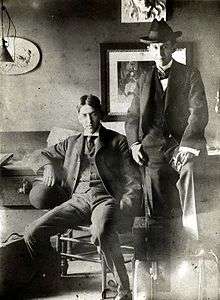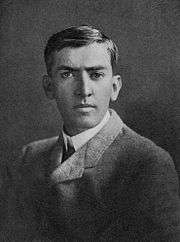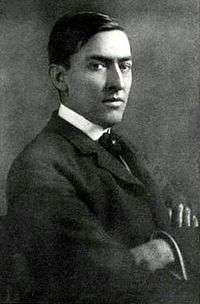George Ade
| George Ade | |
|---|---|
|
George Ade in 1904 | |
| Born |
February 9, 1866 Kentland, Indiana |
| Died |
May 16, 1944 (aged 78) Brook, Indiana |
| Occupation | Writer, newspaper columnist, and playwright |
George Ade (February 9, 1866 – May 16, 1944) was an American writer, newspaper columnist, and playwright.
Biography
George Ade was born in Kentland, Indiana, one of seven children raised by John and Adaline (Bush) Ade. While attending Purdue University, he became a member of the Sigma Chi fraternity. He also met and started a lifelong friendship with fellow cartoonist and Sigma Chi brother John T. McCutcheon and worked as a reporter for the Lafayette Call. He graduated in 1887.[1]
In 1890 Ade joined the Chicago Morning News, which later became the Chicago Record, where McCutcheon was working. He wrote the column, Stories of the Streets and of the Town. In the column, which McCutcheon illustrated, George Ade illustrated Chicago life. It featured characters like Artie, an office boy; Doc Horne, a gentlemanly liar; and Pink Marsh, a black shoeshine boy. Ade's well-known "fables in slang" also made their first appearance in this popular column.
Ade's literary reputation rests upon his achievements as a great humorist of American character during an important era in American history: the first large wave of migration from the countryside to burgeoning cities like Chicago, where, in fact, Ade produced his best fiction. He was a practicing realist during the Age of (William Dean) Howells and a local colorist of Chicago and the Midwest. His work constitutes a vast comedy of Midwestern manners and, indeed, a comedy of late 19th-century American manners. In 1915, Sir Walter Raleigh, Oxford professor and man of letters, while on a lecture tour in America, called George Ade "the greatest living American writer."[2]
Ade's fiction dealt consistently with the "little man," the common, undistinguished, average American, usually a farmer or lower middle class citizen. (He sometimes skewered women, too, especially women with laughable social pretensions.)
Ade followed in the footsteps of his idol Mark Twain by making expert use of the American language. In his unique "Fables in Slang," which purveyed not so much slang as the American colloquial vernacular, Ade pursued an effectively genial satire notable for its scrupulous objectivity. Ade's regular practice in the best fables is to present a little drama incorporating concrete, specific evidence with which he implicitly indicts the object of his satire—always a type (e.g., the social climber). The fable's actual moral is nearly always implicit, though he liked to tack on a mock, often ironic moral (e.g., "Industry and perseverance bring a sure reward").

As a subtle moralist all too aware of the ironies of the modern world, George Ade was perhaps the first modern American humorist. Through the values implicit in the fables, Ade manifested an ambivalence between the traditional rural virtues, in which he was raised (the virtues of Horatio Alger and the McGuffey Readers), and the craftiness he saw all around him in booming Chicago.

The United States, in Ade's lifetime, underwent a great population shift and transfer from an agricultural to an industrial economy. Many felt the nation suffered the even more agonizing process of shifting values toward philistinism, greed, and dishonesty. Ade's prevalent practice is to record the pragmatic efforts of the little man to get along in such a world.
Ade propounds a golden mean, satirizing both hidebound adherence to obsolete standards and too-easy adjustment to new ones. His view is often an ambiguous, ambivalent, pragmatic reaction to the changing scene, but it remains an invaluable literary reflection of the conflicting moral tensions resident in our national culture at the turn of the century.
A striking and unique feature of Ade's essays was the creative and liberal use of capitalization.[3][4] Here is an example:
"Once upon a Time there was a slim Girl with a Forehead which was Shiny and Protuberant, like a Bartlett Pear... In all the Country around there was not a Man who came up to her Plans and Specifications for a Husband. Neither was there any Man who had any time for Her. So she led a lonely Life, dreaming of the One—the Ideal. He was a big and pensive Literary Man, wearing a Prince Albert coat, a neat Derby Hat and godlike Whiskers. When He came he would enfold Her in his Arms and whisper Emerson's Essays to her."[5]
Ade was a playwright as well as an author, penning such stage works as Artie, The Sultan of Sulu (a musical comedy with composer Nathaniel D. Mann and lyricist Alfred George Whathall), The College Widow, The Fair Co-ed, and The County Chairman. He wrote the first American play about football.
After twelve years in Chicago, he built a home near the town of Brook, Indiana (Newton County). It soon became known for hosting a campaign stop in 1908 by William Howard Taft, a rally for Theodore Roosevelt's Bull Moose Party in 1912, and a homecoming for soldiers and sailors in 1919.
George Ade is one of the American writers whose publications made him rich. When land values were inflated about the time of World War I, Ade was a millionaire. The Ross-Ade football stadium at Purdue University was built with his (and David E. Ross's) financial support. He also generously supported his college fraternity, Sigma Chi, leading a fund-raising campaign to endow the Sigma Chi mother house at the site of the fraternity's original establishment at Miami University. Ade is also famous among Sigma Chis as the author of The Sigma Chi Creed, written in 1929, one of the central documents of the fraternity's philosophies.
George Ade died in Brook, Indiana, aged 78. He is buried in Fairlawn Cemetery in Kentland. His home in Iroquois Township, Indiana, the George Ade House, was listed on the National Register of Historic Places in 1976.[6]
Works

- Artie. A story of the streets and town (1896)
- Pink Marsh : a story of the streets and town (1897)
- Doc' Horne (1899)
- Fables in slang (1899)
- More fables (1900)
- American vacations in Europe (1901)
- Forty modern fables (1901)
- Girl proposition (1902)
- The County Chairman (1903)
- Handsome Cyril, or, The messenger boy with the warm feet (1903)
- In Babel; stories of Chicago (1903)
- Circus Day (1903)
- People you know (1903)
- Peggy from Paris: A Musical Comedy in Two Acts (1903)
- Strenuous lad's library (1903)
- Sultan of Sulu; an original satire in two acts (1903)
- Breaking into society (1904)
- The College Widow (1904; adapted as a musical in 1917, Leave It to Jane)
- Sho gun, an original comic opera in two acts (1904)
- True bills (1904)
- Round about Cairo, with and without the assistance of the dragoman or Simon Legree of the Orient (1906)
- The Slim Princess (1907)
- Fair co-ed (1909)
- Old town (1909)
- I Knew Him When : a Hoosier fable dealing with the happy days of away back yonder (1910)
- Hoosier hand book and true guide for the returning exile (1911)
- Verses and jingles (1911)
- Just out of college; a light comedy in three acts (1912)
- Knocking the neighbors (1913)
- Ade's fables (1914)
- The Fable of the Roistering Blades (1915)
- Invitation to you and your folks from Jim and some more of the home folks (1916)
- Marse Covington; a play in one act (1918)
- Hand-made fables (1920)
- Single blessedness, and other observations (1922)
- Mayor and the manicure; a play in one act (1923)
- Nettie, a play in one act (1923)
- Speaking to father; a play in one act (1923)
- Father and the boys; a comedy-drama (1924)
- The Sigma Chi Creed (1929)
- On the Indiana trail (1930)
- Old-time saloon: not wet--not dry, just history (1931)
- Thirty fables in slang (1933)
- One afternoon with Mark Twain (1939)
- Notes & reminiscences (with John T. McCutcheon) (1940)
- The America of George Ade, 1866-1944; fables, short stories, essays (edited and introduced by Jean Shepherd) (1960)
In fiction
- Ade is on a journey to Mars with Nikola Tesla and Mark Twain in the 2005 novel Wonder of the Worlds by Sesh Heri.
- P. G. Wodehouse refers to Ade's "The Fable of the Author Who Was Sorry for What He Did to Willie" in Love Among the Chickens (1909) ("The whole thing began like Mr. George Ade's fable of the author. An author — myself — was sitting at his desk trying to turn out something that could be converted into breakfast food, when a friend came in and sat down on the table and told him to go right on and not mind him." (Chapter XII) and "I felt, like the man in the fable, as if some one had played a mean trick on me, and substituted for my brain a side order of cauliflower." (Chapter XVI)) He uses the same sentence again in Mike (1909) (But that Adair should inform him, two minutes after Mr. Downing’s announcement of Psmith’s confession, that Psmith, too, was guiltless, and that the real criminal was Dunster — it was this that made him feel that somebody, in the words of an American author, had played a mean trick on him, and substituted for his brain a side-order of cauliflower. (Chapter LVIII))
References
- ↑ Leonard, John William; Marquis, Albert Nelson, eds. (1908), Who's who in America, 5, Chicago: Marquis Who's Who, Incorporated, p. 13.
- ↑ Coyle, Lee (1964). George Ade. New York: Twayne Publisher, Inc. p. 7.
- ↑ Dictionary of Midwestern Literature, Philip A. Greasley, Indiana University Press, 2001, p. 28.
- ↑ Biography by Luc Sante.
- ↑ Excerpt from THE FABLE OF THE SLIM GIRL WHO TRIED TO KEEP A DATE THAT WAS NEVER MADE at Project Gutenberg.
- ↑ National Park Service (2010-07-09). "National Register Information System". National Register of Historic Places. National Park Service.
External links
| Wikisource has original works written by or about: George Ade |
- Works by George Ade at Project Gutenberg
- Works by or about George Ade at Internet Archive
- Works by George Ade at LibriVox (public domain audiobooks)

- Over 150 George Ade stories read in Mister Ron's Basement Podcast, now indexed to make them easy to find
- George Ade Digital Exhibit at Purdue University Libraries The Libraries Archives and Special Collections holds many of Ade's original works.
- George Ade at Find a Grave
- George Ade Papers 1865-1971 at The Newberry Library
